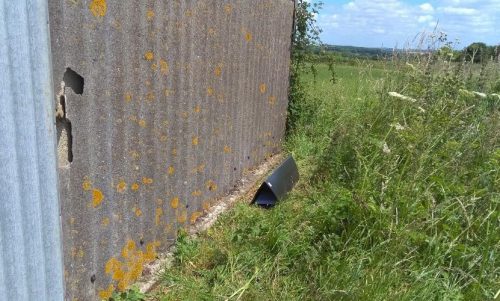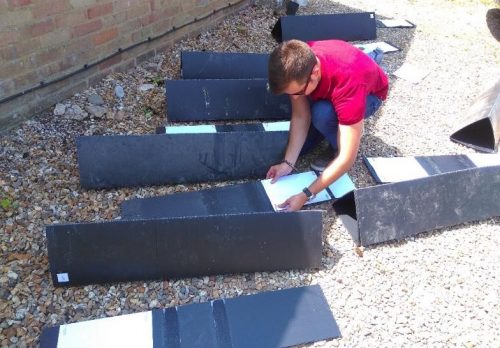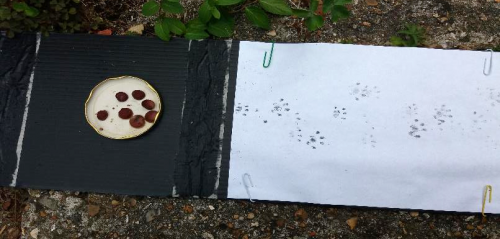The most effective way to survey a large rural area for hedgehogs is to use a set of baited footprint tracking tunnels, a method designed by the People’s Trust for Endangered Species (PTES). If ten baited tunnels are set in up to 1-km2 for five consecutive nights and NO hedgehog footprints are detected, the surveyor can be 95% sure that hedgehogs are ABSENT from the area. The footprints are charming, a bit like toddler handprints!
Hedgehog tunnel placed alongside a farm building © Jess Brooks
- To survey 1×1-km square, you will need:
- 10 tunnels. You can buy them or make your own.
- 20 tent pegs
- Roll of wide masking tape
- 500ml vegetable oil and 500g black powder paint or charcoal, mixed in a screw-top jar or bottle with a paintbrush for application
- 20 petri or shallow bait dishes
- 1 can of hotdogs chopped into 1cm slices for bait
- Pack of A4 paper and 80 paperclips
- Identify 10 locations spread across the 1×1-km square. They must be 100m apart, and convenient enough to access so you can check them easily.
- In each location, choose a linear feature to set the tunnel up on – the most likely path you think the hedgehog will take, remembering they like to ‘hog’ boundaries (e.g. building wall, hedgerow base, edge of arable crop, fence line, edge of vehicle track).
- Set up the tunnel:
- Place a dish of bait in the centre of the removable ‘tracking plate’.
- Put a strip of masking tape either side of the bait, and paint with ink.
- Clip a sheet of A4 paper to the ends of the tracking plate.
- Pierce a hole in either end of the tracking plate and the outer tunnel.
- Position the tunnel and push the pegs through the holes to secure.
- Leave the tunnels in place for 5 nights, and check the tunnels once a day, collecting in on the 6th Refresh the bait, ink and paper as required.
- Record the grid reference of each tunnel (or mark on a map), make a note of the dates and weather conditions, and what prints were found in what tunnel. To help identify prints, use the PTES footprint tunnel guide.
- Move elsewhere and do another 1×1-km square, if desired.
- Enter data onto the Big Hedgehog Map or your chosen recording site
All hedgehog tunnel photos © Jess Brooks



